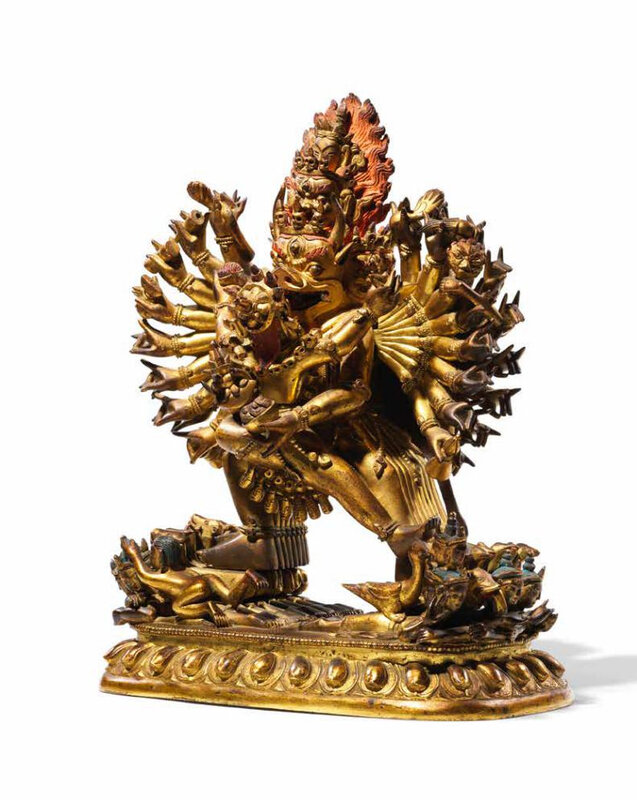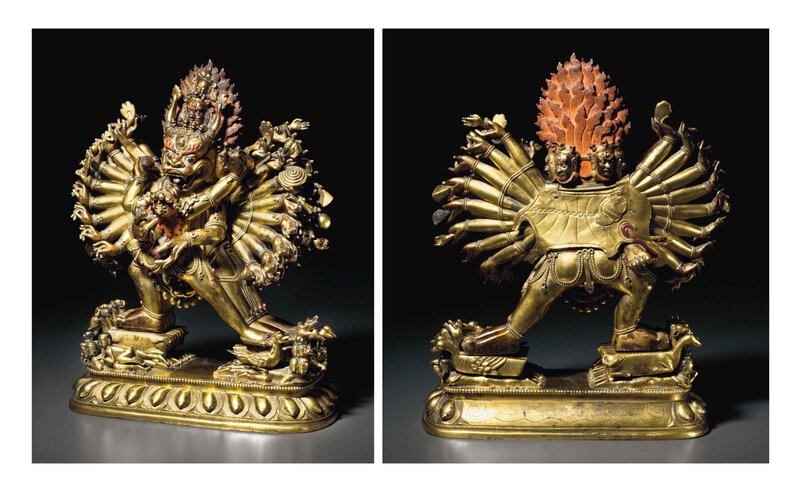A fine gilt-bronze figure of Vajrabhairava and Vajravetali, Qing Dynasty, 18th century
Lot 13. A fine gilt-bronze figure of Vajrabhairava and Vajravetali, Qing Dynasty, 18th century; 23cm (9in) high. Estimate 1,000,000-1,500,000 HKD. Sold for HK$ 1,250,000 (€ 136,830) inc. premium. © Bonhams 2001-2018
The yidam and consort striding in alidhasana trampling a menagerie of animals including geese and bulls raised on prone figures of deities on a separate beaded lotus throne, the central ferocious buffalo face surrounded by six human faces and two above, the primary hands wrapped around his consort holding a chopper and a skull cup, the other thirty-two radiating arms holding various implements, adorned with elaborate beaded jewellery and a garland of severed heads, box.
Provenance: Mr R.P. Collection, France, acquired in China and Tibet between 1910 and 1925, by repute.
Note: The powerfully cast figure of Vajrabhairava with his consort Vajravetali is a very fine example of Buddhist sculptures commissioned under the fertile cross-influence between the Imperial Court and Tibetan monastic seats of power during the Qing dynasty.
Yamantaka Vajrabhairava is a wrathful form of Manjushri, the Bodhisattva of Discriminating Wisdom, and is a destroyer of ignorance and fear of death. He is one of the principal meditation deities in the Gelug Tradition of Tibetan Buddhism founded by Tsongkhapa (1357-1419). The Gelug lineage became the dominant religious power in Tibet during the 17th century and was later favoured by the Qing Court.
Tsongkhapa and the Qing emperors also promoted themselves as manifestations of the bodhisattva Manjushri, thus contributing to the proliferation of images of Vajrabhairava within China. During the 18th century, the Qianlong emperor further maintained direct links with the Dalai and Panchen Lamas for both religious and political considerations, underlined by the construction of a large number of temples in and around Beijing. Images of Vajrabhairava, therefore, carried both religious and Imperial connotations, endorsing the Mandate of Heaven of the emperor.
This impressive and heavily-cast figure of Vajrabhairava is skilfully constructed in several pieces and fitted together. Compare a similar figure illustrated by Hung Shih Chang and Jessica P.P. Hsu, eds., Buddhist Art from Rehol: Tibetan Buddhist Images and Ritual Objects from the Qing Dynasty Summer Palace at Chengde, Taipei, 1999, p.122, pl.46.
Compare the modelling, construction and style of the present figure with two slightly smaller examples of Vajrabhairava in ecstatic union, 18th century; the first which was sold at Christie's New York, 15th-16th March 2015, lot 3214, and the second which was sold at Sotheby's Hong Kong, 3 April 2018, lot 3679.
A gilt-bronze figure of Vajrabhairava and Vajra Vetali, Qianlong period (1736-1795); 13 ½ in. (34.3 cm.) high. Sold for 545,000 USD (Estimate USD 200,000 - USD 300,000) at Christie's New York, 15th-16th March 2015, lot 3214. © Christie's Images Ltd 2015
The wrathful, meditational deity is shown striding in alidhasana on animals and prostrate figures on a lotus base. In his primary hands he holds a curved knife and skull cup and in the multitude of other outstretched hands he holds various implements. The central face is in the form of a ferocious buffalo, with bulging eyes and flaming brows, and is flanked and surmounted by additional human faces. His consort, Vetali, stands before him with her left leg wrapped around his waist, holding a skull cup and curved knife.
Provenance: Important private collection, France, acquired 1960-1990.
Note: The present figure represents the ferocious, thirty-four-armed form of the deity Vajrabhairava, a manifestation of the bodhisattva Manjushri, with his consort, Vajra Vetali. Vajrabhairava is one of the principle meditational deities in the Gelug sect of Tibetan Buddhism, which from the 17th century was the dominant religious power in Tibet. The Qing emperors maintained direct links with the dignitaries of the Gelug sect, including the Dalai and Panchen Lamas, and propagated this form of Buddhism within China itself, sponsoring the lavish construction of numerous temples in and around the capital of Beijing. In the 18th century, the Qianlong Emperor promoted himself as a manifestation of Manjushri as well, underlining his wisdom, compassion, and spiritual transcendence. Images of Vajrabhairava, therefore, carried both a religious and political weight, fulfilling their role within Gelug worship and practice, while simultaneously promoting the lineage of the Emperor.
This impressive and heavily-cast figure is cleverly constructed in several pieces, including, unusually, the upper half of the goddess' body, which attaches to the lower half and the main figure with a tang and socket. The deity strides on the backs of Hindu gods, identified by Jeff Watt as Brahma, Indra, Vishnu, Shiva, Kartikkeya, Ganesha, Surya, and Chandra. Each deity, as well as each aspect of Vajrabhairava's appearance, acts as a mnemonic device for remembering the meditational worship of the god.
A gilt-bronze figure of Yamantaka and Vajra Vetali, Qing dynasty, 18th century; 20 cm, 7 7/8 in. Sold for 1,187,500 HKD (Estimate 600,000 — 800,000 HKD) at Sotheby's Hong Kong, 3 April 2018, lot 3679. Courtesy Sotheby's.
cast in the form of the yidam and consort standing in alidhasana on trampled figures, birds and bovine animals, all atop a lotus base with a beaded upper edge, the buffalo-headed yidam portrayed ferocious with bulging eyes and a gaping mouth, surmounted by flaming hair, with thirty-two outstretched arms and a pair wrapped around the consort, holding in some of his hands implements and ritual weapons, further depicted adorned with a garland of severed skulls, the consort rendered in ecstatic union with the yidam and holding a kapala filled with amrita in the raised left hand and a kartrika in the right.
Note: The complex and powerfully modelled sculpture depicts Yamantaka Vajrabhairava, the wrathful manifestation of Manjushri, the Bodhisattva of Discriminating Wisdom, together with his consort Vajravetali in ecstatic union. The large and ferocious buffalo head of Vajrabhairava with towering, fiery tresses coiled into thick ropes dominate the sculpture and commands the focal point, as it is the same size as the torso and legs. Six fierce human faces wrap around the back of the buffalo head, and are surmounted by a further fierce human face and the head of wrathful Manjushri.
Vajrabhairava, or Adamantine Anger, the destroyer of ignorance and fear of death, is one of the principal yidams of the Geluk sect, the Tibetan Buddhist order founded by Tsongkhapa (1357-1419) that was later favoured at the Qing court. The Geluk sect enjoyed increased importance amongst the emperors of the Ming dynasty. From the mid-17th century on, The Geluk lineage were the dominant theocratic power in Tibet through the Dalai Lama, and the sole represented Tibetan Buddhist lineage within China.
Tsongkhapa, as well as the Manchu emperors, were additionally considered manifestations of the bodhisattva Manjushri, explaining in part the popularity of Vajrabhairava within China. The Qing emperors maintained direct links with the Dalai and Panchen Lamas and propagated the Geluk lineage of Buddhism within China, sponsoring the construction of numerous monasteries and temples around the capital of Beijing. Vajrabhairava, the all-powerful manifestation of Manjushri, was thereby symbolic of the ultimate imperial authority. This awe-inspiring statue serves to enforce the imperial mandate while representing the highest ideals of the spiritual path to Buddhist enlightenment.
Another figure of similar size, iconography and workmanship is illustrated by Hung Shih Chang and Jessica P.P. Hsu, eds. Buddhist Art from Rehol: Tibetan Buddhist images and ritual objects from the Qing dynasty Summer Palace at Chengde, Taipei, 1999, p. 122, pl. 46. See also a closely related gilt-bronze figure of Yamantaka and Vajravetali, sold at Christie's New York, 15th-16th March 2015, lot 3214.
Bonhams. FINE CHINESE CERAMICS AND WORKS OF ART, 29 May 2018, 14:00 HKT, HONG KONG, ADMIRALTY

/https%3A%2F%2Fprofilepics.canalblog.com%2Fprofilepics%2F1%2F0%2F100183.jpg)
/https%3A%2F%2Fstorage.canalblog.com%2F03%2F02%2F119589%2F96711876_o.jpg)
/https%3A%2F%2Fstorage.canalblog.com%2F11%2F31%2F119589%2F94773502_o.jpg)
/https%3A%2F%2Fstorage.canalblog.com%2F20%2F83%2F119589%2F94772815_o.jpg)
/https%3A%2F%2Fstorage.canalblog.com%2F26%2F72%2F119589%2F75604929_o.jpg)
/https%3A%2F%2Fstorage.canalblog.com%2F59%2F60%2F119589%2F26458628_o.jpg)








/http%3A%2F%2Fstorage.canalblog.com%2F21%2F96%2F119589%2F129836760_o.jpg)
/http%3A%2F%2Fstorage.canalblog.com%2F33%2F99%2F119589%2F129627838_o.jpg)
/http%3A%2F%2Fstorage.canalblog.com%2F07%2F83%2F119589%2F129627729_o.jpg)
/http%3A%2F%2Fstorage.canalblog.com%2F28%2F37%2F119589%2F129627693_o.jpg)